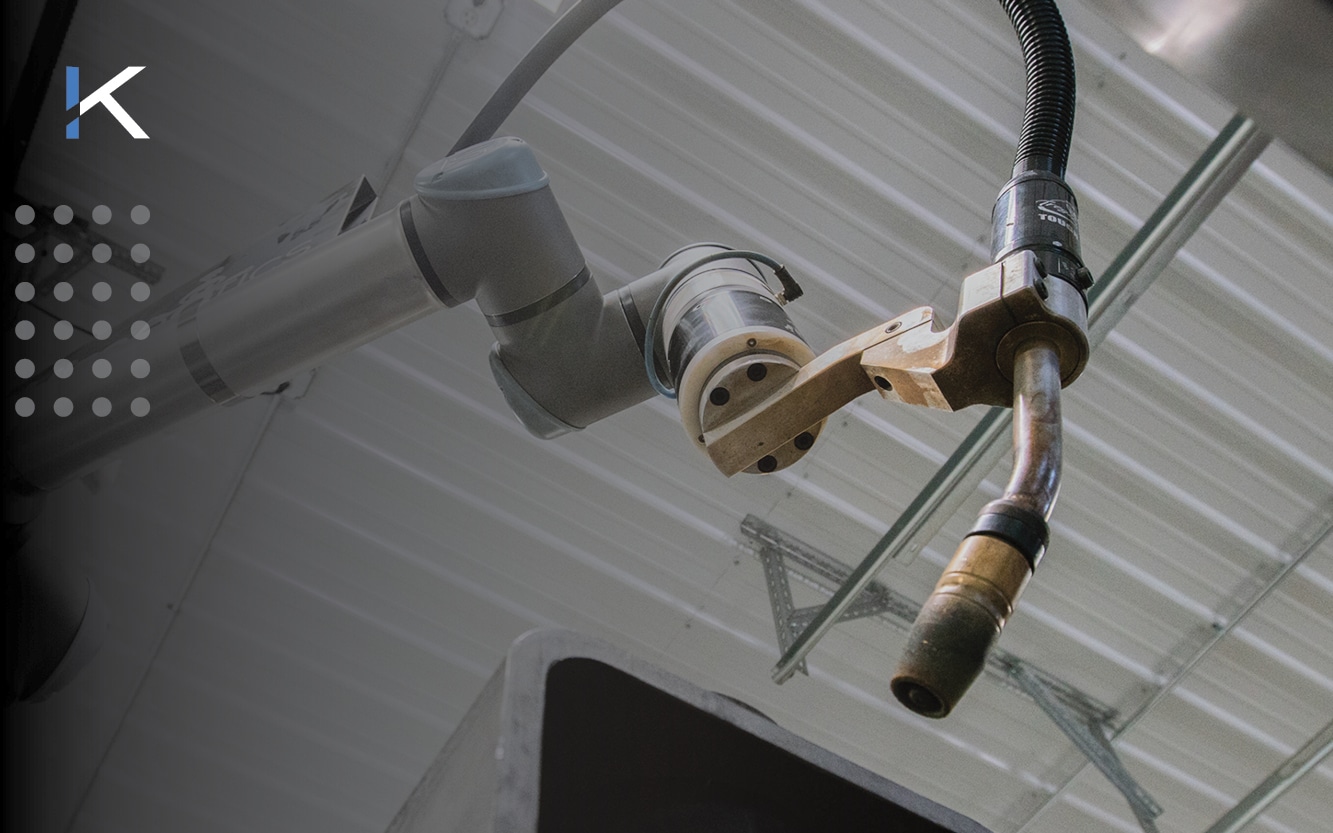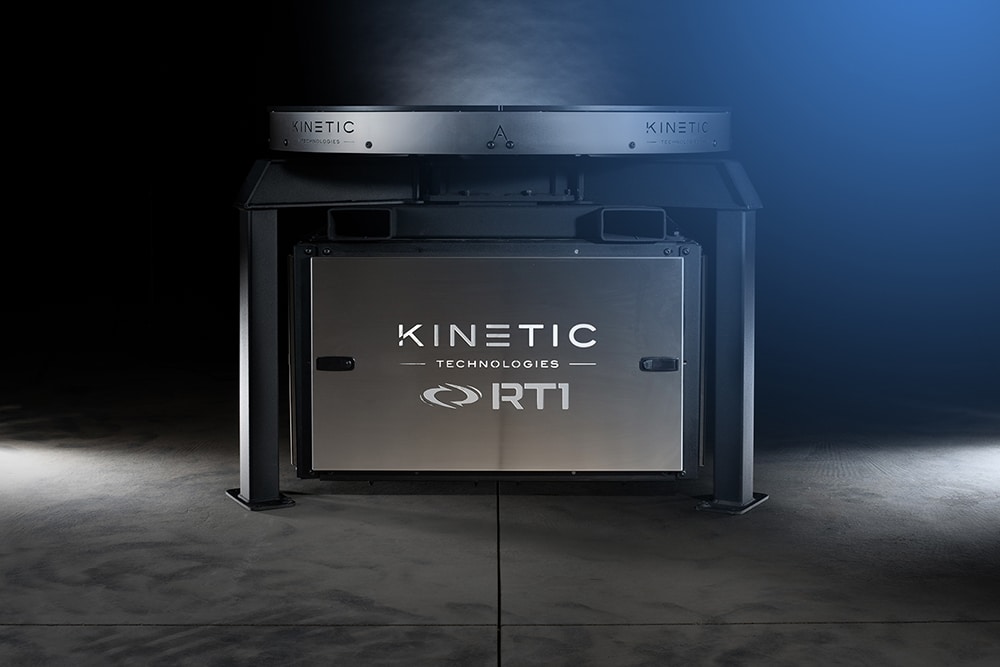
In recent years, the manufacturing and fabrication industry has been increasingly constrained by increased demand due to reshoring and the skilled labor shortage. These trends have created a pressing need to do more with less.
Automation technologies, such as robotic welding, can help to bridge this gap. Not only do they ensure consistent quality and high throughput, they also offer solutions to many of the current manufacturing challenges companies face.
In this article, we will explore the advantages of robotic welding in the manufacturing and fabrication industries. We will discuss how robotic welding can benefit manufacturers and enhance productivity, efficiency, and quality in the welding process.
In this article
• Robotic Welding Options: Solution for Modern Manufacturing ›
• Importance of Choosing the Right Fixtures and Positioners for Optimized Welding ›
• The Advantages of Robotic Welding: A Game-Changer for Your Business ›
• Kinetic Technologies’ Approach to Automation Projects ›
• Embrace the Future with Robotic Welding ›
Robotic Welding Options: Solutions for Modern Manufacturing
Robotic welding systems consist of a robotic arm equipped with a TIG, MIG, or arc welding system. These robotic arms are programmed to execute welding operations according to predetermined parameters. The system is then integrated with other equipment and components to create a complete automated welding platform.
Factors To Consider When Selecting a Robotic Welding Solution
To start your journey in robotic welding, having a dedicated ‘champion’ within your organization is beneficial. This individual, invested in the project and a fast learner, can collaborate with suppliers and bring valuable knowledge of your company’s operations as a subject matter consultant. Their commitment greatly contributes to project success.
Next, decide which part you want to produce. Choose a simple part with medium production volume. This will allow your team to learn and adapt without the pressure of high-volume production, but with enough run rate to observe a difference. This first project will need adjustments, but the lessons learned will make subsequent projects smoother. Simplicity is key in this initial phase.
Robotic Technology
To maximize efficiency and productivity, it is important to choose the correct robot for your welding operation. There are two primary types of robots used in welding: traditional industrial robots and collaborative robots, or ‘cobots.’
Traditional welding robots excel in situations that require high speed, precision, and heavy payload. They are often used in large-scale production where repetitive tasks and high throughput are required. However, these robots usually need to operate in a segregated environment for safety reasons, as they lack the sensory capabilities to co-exist with humans in close proximity.
Collaborative robots (Cobots) are designed to work safely alongside human welders in a shared workspace. Cobots are equipped with advanced sensors and safety features that allow them to stop or slow down when a human worker enters their working zone. They are particularly useful in smaller scale operations or when tasks require human-robot collaboration.
Once you’ve selected the right type of robot, programming is the next crucial step. For example, cobots offer simplified programming, making them more user-friendly for workers that do not have extensive robotic programming skills.
Regardless of whether you opt for a traditional robot or a cobot, programming is essential to instruct the robot on what tasks to perform and how to perform them. This process involves setting the parameters for the welding operation, including speed, path, angle, and distance.
Importance of Choosing the Right Fixtures and Positioners for Optimized Welding
Selecting the right fixtures and positioners is a critical aspect of a successful welding process. These components not only directly influence the precision of the welds, but also the overall productivity and efficiency of your operations.

– Fixtures serve to accurately position and hold the workpieces during the welding process, placing each weld precisely according to design specifications. The right fixture can significantly increase the quality of your welds, resulting in fewer weld defects, reworks, and rejects.
– Positioners manipulate the workpieces to present the weld joints to the welding torch in the most optimal position. This enables easy access to complex and hard-to-reach weld joints, creating a smooth and uniform workflow and increasing the process efficiency.
The Impact of a Well-Planned Fixturing Strategy on the Production Process
A well-planned fixturing strategy can be a game-changer for your production process. Reducing setup and changeover times enables faster throughput and higher productivity. It also allows for a consistent and repeatable welding process, ensuring that each product meets the same high-quality standards as manual workholding.
Optimizing fixturing and positioning reduces the need for manual intervention in the welding process, minimizing the risk of errors and safety hazards. This not only safeguards the health and safety of your staff, but also protects your investment in materials and machinery.
A sound fixturing strategy is an indispensable component of a successful and profitable robotic welding process. By investing time and resources in optimizing your fixtures and positioners, you pave the way for a smoother, more efficient, and cost-effective robotic welding operation.
The Advantages of Robotic Welding: A Game-Changer for Your Business
Now that we have discussed the basics of robotic welding, let’s look at how it can transform your business.
Here are the five most notable advantages of robotic welding:
Consistent Welding Workflows: Robotic welding provides consistency in the welding process, ensuring that every weld meets design specifications. A high-quality weld requires precise parameters and repeatability, which can be difficult to achieve even by the most skilled welders. This process reliability is critical for high-precision industries.
Increased Weld Quality and Efficiency: Robotic welding systems are known for their accuracy and precision, resulting in superior weld quality. The high-speed operation of these systems significantly increases productivity, boosting overall efficiency.
Conserve Raw Materials: Robotic welding systems optimize efficiency, which helps in reducing waste during the welding process. This conservation of raw materials can significantly reduce production costs and contribute to sustainable manufacturing practices.
Reduced Labor Costs: Introducing robotic welding can lead to significant savings in labor costs. While there may be an initial investment for the setup and programming of these systems, the long-term savings make it a worthwhile investment. With a robotic welding system, you empower your existing workforce to take on more specialized tasks.
Safer Operations: Safety is paramount in any manufacturing environment, and introducing robotic welding can greatly improve workplace safety. Robots can handle tasks in environments that may be hazardous to human workers, reducing the risk of workplace accidents and injuries.
Kinetic Technologies’ Approach to Automation Projects
Every automation project is unique and comes with its own set of challenges. Our goal is to address the unique challenges of your welding operation and develop a customized solution that is tailored to your business.
Our process begins with our design team, who collaborates with a wide network of supplier partners. This approach allows us to maximize the success of your automation project. We carefully select the right robot for your specific needs, integrate necessary subcomponents, and customize the environment around it.
But our support doesn’t stop there. Kinetic’s robotics engineering team extensions are also well-equipped to handle electronics integration and UI software development. This expertise ensures a successful outcome for the specific challenges your project presents.
Steps to Successful Integration
Integrating robotic welding into your operations is a multi-step process that requires careful consideration and planning. Here are the key steps to a successful integration:
Identify Your Needs: The first step to successfully integrate robotic welding is to clearly understand your needs. Identify which parts require welding, the volume of production, and the desired speed and efficiency. This will heavily influence the robot selection process.
Select the Right Robot: The choice between a traditional industrial robot and a collaborative robot will greatly depend on your specific operational requirements, budget, safety considerations, and the level of human-robot interaction required. The right robot can significantly increase the quality and efficiency of your welds while minimizing errors and rework.
Integrate Subcomponents: Once the robot is chosen, the integration of necessary subcomponents follows. These assets may include, but are not limited to, welding equipment (welding torch, power supply), safety systems (light curtains, safety mats), fixtures, positioners, and material handling systems. The choice of each subcomponent is as critical as the choice of the robot. They should work seamlessly together to maximize the efficiency and productivity of your operation.
Customize the Environment: The environment around the robot needs to be customized to best suit your operation. This includes setting up the necessary protective barriers or enclosures and optimizing the workflow around the robot. For example, the layout of the workstation should be organized in a way that the components are easily accessible to the robot, and the robot’s tasks don’t disrupt other operations. The more efficiently the workstation is laid out, the faster each operation can occur.
Programming and Testing: After setting up the environment, programming the robot according to the specific welding tasks is essential. Once programmed, an extensive testing and optimization phase should follow. This allows you to fine-tune the operations, making them as efficient and error-free as possible.
Embrace the Future with Robotic Welding
Robotic welding provides a clear path to increased productivity, enhanced efficiency, and higher profitability. This advanced technology offers many benefits, including precision welding, reduced errors, and minimized rework. It dramatically reduces the occurrence of safety hazards, safeguarding both your team and your investment.
Taking the step toward automation is a significant investment, but its return is substantial. Companies that have already adopted robotic welding have experienced a dramatic improvement in their production process, and they are reaping the rewards of increased flexibility, reduced labor costs, and improved product quality.
Partner with Kinetic Technologies for Seamless Integration
Finding a trusted, reliable manufacturing automation partner can feel overwhelming. You want to find someone innovative and knowledgeable enough to help you scale your business with the best-in-class automation solutions.
But with so many different companies claiming to offer services, how do you know who to trust?
Kinetic Technologies is your one-stop manufacturing partner for automation solutions and custom manufacturing services. We seamlessly integrate with your team to provide the best robotic welding solutions for your business. Our team of experienced engineers works closely with you to ensure that your robotic welding process is optimized and tailored to your specific needs.
Ready to get started? Get in touch with us today and learn how Kinetic Technologies can help you take advantage of the many benefits that automation has to offer!


